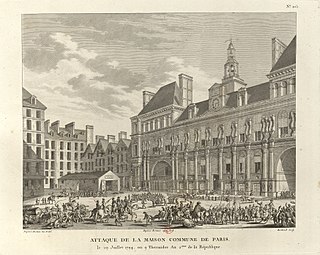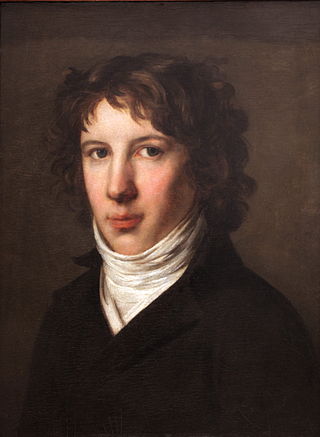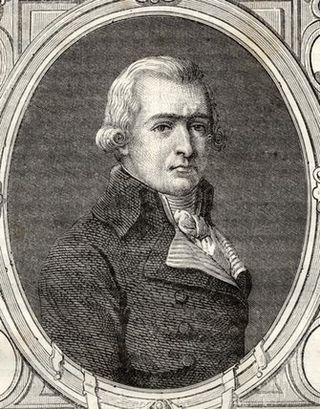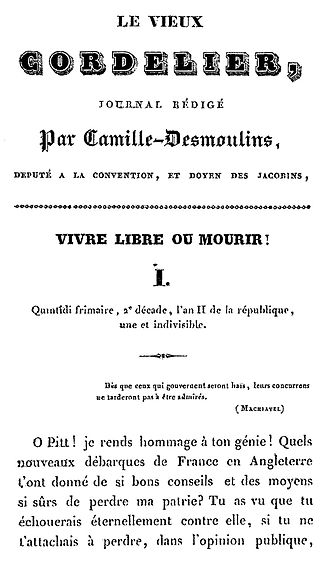
Georges Jacques Danton ; was a French lawyer and a leading figure in the French Revolution. He became a deputy to the Paris Commune, presided in the Cordeliers district, and visited the Jacobin club. A modest and unknown lawyer on the eve of the Revolution, Danton became a famous orator of the Cordeliers Club and was raised to governmental responsibilities as French Minister of Justice following the fall of the monarchy on 10 August 1792, and was subsequently responsible for inciting the September Massacres. In Spring 1793 he supported the foundation of a Revolutionary Tribunal and became the first president of the Committee of Public Safety. Danton was sent to Belgium as commissioner to deal with Dumouriez.

The Committee of Public Safety, was a committee of the National Convention which formed the provisional government and war cabinet during the Reign of Terror, a violent phase of the French Revolution. Supplementing the Committee of General Defence, created early January 1793, the Committee of Public Safety was created on 6 April 1793 by the National Convention. It was charged with protecting the new republic against its foreign and domestic enemies, fighting the First Coalition and the Vendée revolt. As a wartime measure, the committee was given broad supervisory and administrative powers over the armed forces, judiciary and legislature, as well as the executive bodies and ministers of the convention.

The Society of the Friends of the Constitution, renamed the Society of the Jacobins, Friends of Freedom and Equality after 1792 and commonly known as the Jacobin Club or simply the Jacobins, was the most influential political club during the French Revolution of 1789. The period of its political ascendancy includes the Reign of Terror, during which well over 10,000 people were put on trial and executed in France, many for political crimes.

Lucie-Simplice-Camille-Benoît Desmoulins was a French journalist, politician and a prominent figure of the French Revolution. He is best known for playing an instrumental role in the events that led to the Storming of the Bastille. Desmoulins was also noted for his radical criticism of the Reign of Terror as the editor of the journal Le Vieux Cordelier. He was a schoolmate and close friend of Maximilien Robespierre and a close friend and political ally of Georges Danton, who were the leading figures in the French Revolution.

Antoine Quentin Fouquier de Tinville, also called Fouquier-Tinville and nicknamed posthumously the Provider of the Guillotine was a French lawyer and accusateur public of the Revolutionary Tribunal during the French Revolution and Reign of Terror.

The Society of the Friends of the Rights of Man and of the Citizen, mainly known as Cordeliers Club, was a populist political club during the French Revolution from 1790 to 1794, when the Reign of Terror ended and the Thermidorian Reaction began.

The Mountain was a political group during the French Revolution. Its members, called the Montagnards, sat on the highest benches in the National Convention. The term, first used during a session of the Legislative Assembly, came into general use in 1793. By the summer of 1793, that pair of opposed minority groups divided the National Convention. That year, the Montagnards were influential in what is commonly known as the Reign of Terror.

The Paris Commune during the French Revolution was the government of Paris from 1789 until 1795. Established in the Hôtel de Ville just after the storming of the Bastille, it consisted of 144 delegates elected by the 60 divisions of the city. Before its formal establishment, there had been much popular discontent on the streets of Paris over who represented the true Commune, and who had the right to rule the Parisian people. The first mayor was Jean Sylvain Bailly, a relatively moderate Feuillant who supported constitutional monarchy. He was succeeded in November 1791 by Pétion de Villeneuve after Bailly's unpopular use of the National Guard to disperse a riotous assembly in the Champ de Mars.

The September Massacres were a series of killings of prisoners in Paris that occurred in 1792, from Sunday, 2 September until Thursday, 6 September, during the French Revolution. Between 1,176 and 1,614 people were killed by fédérés, guardsmen, and sans-culottes, with the support of gendarmes responsible for guarding the tribunals and prisons, the Cordeliers, the Committee of Surveillance of the Commune, and the revolutionary sections of Paris.

Louis Antoine Léon de Saint-Just, sometimes nicknamed the Archangel of Terror, was a French revolutionary, political philosopher, member and president of the French National Convention, a Jacobin club leader, and a major figure of the French Revolution. He was a close friend of Maximilien Robespierre and served as his most trusted ally during the period of Jacobin rule (1793–94) in the French First Republic. Saint-Just worked as a legislator and a military commissar, but he achieved a lasting reputation as the face of the Reign of Terror. He publicly delivered the condemnatory reports that emanated from the Committee of Public Safety and defended the use of violence against opponents of the government. He contributed to the arrests of some of the most famous figures of the Revolution, many of whom ended up at the guillotine.
The Hébertists, or Exaggerators were a radical revolutionary political group associated with the populist journalist Jacques Hébert, a member of the Cordeliers club. They came to power during the Reign of Terror and played a significant role in the French Revolution.

The Revolutionary Tribunal was a court instituted by the National Convention during the French Revolution for the trial of political offenders. In October 1793 it became one of the most powerful engines of the Reign of Terror.

Jean-Pierre-André Amar or Jean-Baptiste-André Amar was a French political figure of the Revolution and Freemason.

La Révolution française is a two-part 1989 historical drama co-produced by France, Germany, Italy and Canada for the 200th anniversary of the French Revolution. The full film runs at 360 minutes, but the edited-for-television version is slightly longer. It purports to tell a faithful and neutral story of the Revolution, from the calling of the Estates-General to the death of Maximilien de Robespierre. The film had a large budget and boasted an international cast. It was shot in French, German and English.

Antoine-François Momoro was a French printer, bookseller and politician during the French Revolution. An important figure in the Cordeliers club and in Hébertisme, he is the originator of the phrase ″Unité, Indivisibilité de la République; Liberté, égalité, fraternité ou la mort″, one of the mottoes of the French Republic.
During the French Revolution, modérantisme or the faction des modérés was the name the Montagnards gave to their relatively more moderate opponents, first the Girondins and then the Dantonists. Modérantisme was denounced before the Jacobin and the Cordeliers clubs, who then led the first attacks on it in 1794.

Le Vieux Cordelier was a French journal published by Camille Desmoulins between 5 December 1793 and 3 February 1794 at the instigation of Georges Danton and warned not to exaggerate the revolution. Desmoulins argued that the French Revolution should return to its original ideas en vogue around 10 August 1792.

Maximilien François Marie Isidore de Robespierre was a prominent French lawyer and statesman, widely recognized as one of the most influential, and controversial figures of the French Revolution. Robespierre played a pivotal role in the events that led to the downfall of the French monarchy on 10 August 1792 and the subsequent convening of the National Convention. His vision was centered on forging a unified and indivisible France, establishing equality under the law, eradicating prerogatives, and staunchly upholding the principles of direct democracy.

Pierre Louis Bentabole was a revolutionary Frenchman, born in Landau Haut Rhin on 4 June 1756 and died in Paris on 22 April 1798. As lawyer, he presided practiced in the district of Hagenau and Saverne; he was deputy of the Bas-Rhin to the National Convention on 4 September 1792. He voted to execute Louis XVI. On 6 October 1794, he was appointed to the Committee of Public Safety.

The Coup d'état of 9 Thermidor or the Fall of Maximilien Robespierre is the series of events beginning with Maximilien Robespierre's address to the National Convention on 8 Thermidor Year II, his arrest the next day, and his execution on 10 Thermidor. In the speech of 8 Thermidor, Robespierre spoke of the existence of internal enemies, conspirators, and calumniators, within the Convention and the governing Committees. He refused to name them, which alarmed the deputies who feared Robespierre was preparing another purge of the Convention.

















